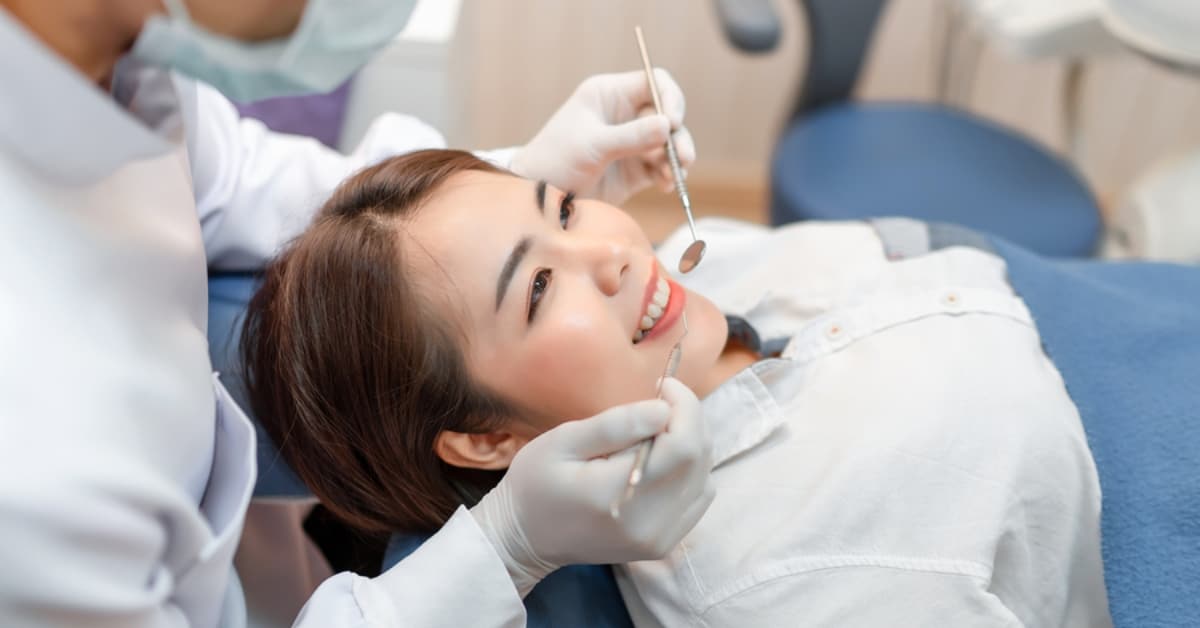
The average orthodontist makes a six-figure salary. But the many years of dental school and specialized training in orthodontics also means racking up multiple six-figure student debt.
What are the best ways orthodontists can pay back their student debt? And is it even worth it to take out that much debt to become an orthodontist? Let’s explore answers to those questions.
Requirements to become an orthodontist
Patients have a love-hate relationship with orthodontists. On one hand, the appliances and orthodontic treatments needed to form a perfect bite or smile aren’t much fun and can be uncomfortable. But in the end, few things are more rewarding than watching the reaction a patient has when their treatment plan is over and they can then freely smile.
Aside from the cosmetic aspect, what's really happening is that orthodontists are treating malocclusion, which is the condition of teeth being out of alignment when the mouth is closed. This condition can be caused by misaligned teeth, an improper bite, mismatched jaw or something more severe.
Because of the specialization beyond general dentistry, orthodontists require a great deal of higher education. First, they need to complete a four-year dental school program with either a Doctor of Dental Surgery (DDS) or Doctor of Dental Medicine degree (DMD). Then complete a two- to three-year accredited orthodontic residency program. Finally, they have to complete a written and clinical examination to become a board certified orthodontist. This board certification needs to be renewed every 10 years.
Here’s a great graphical roadmap of this career path from the American Board of Orthodontics:
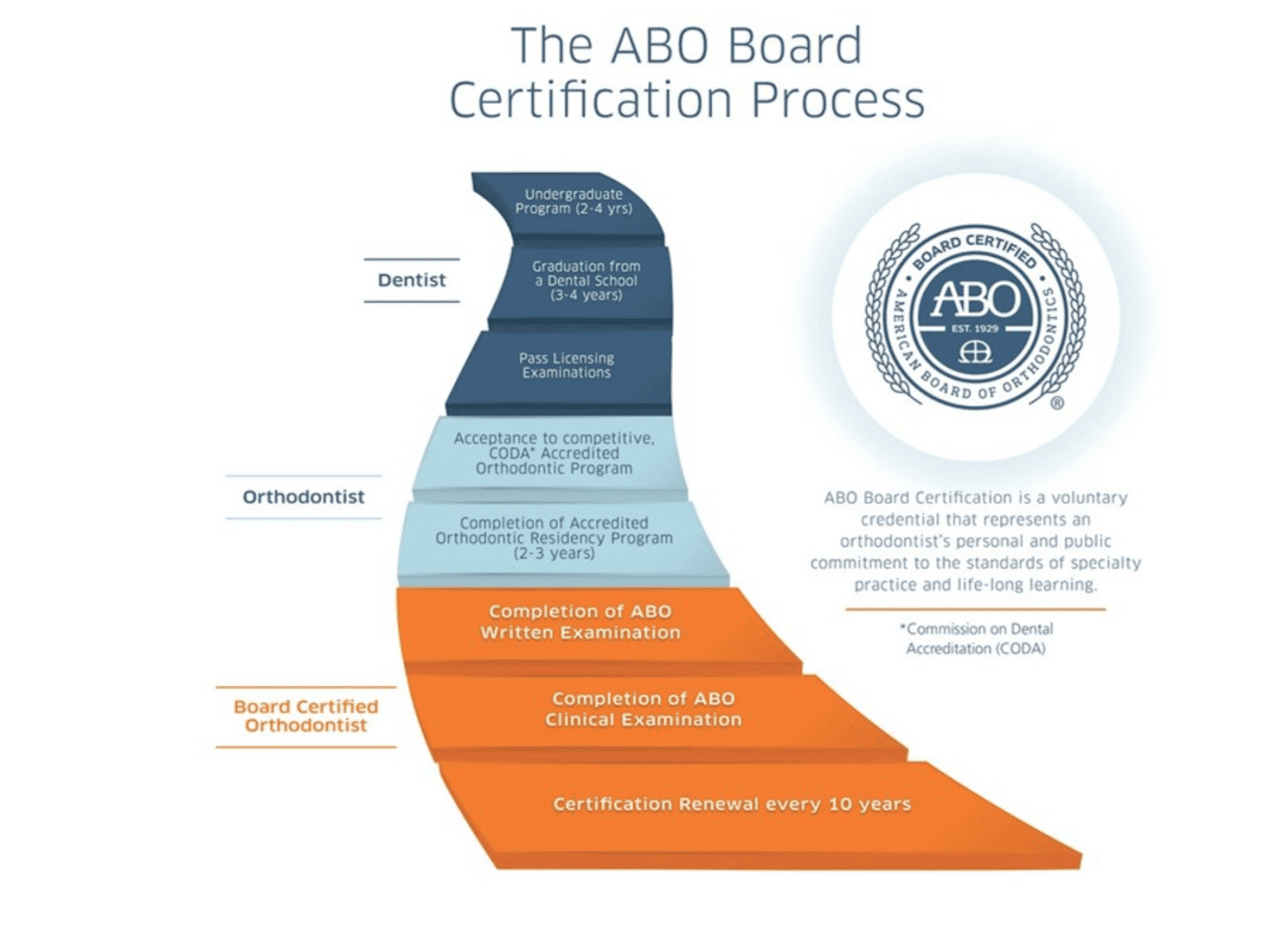
It’s a long and expensive road filled with hard work. But it can be rewarding to see the patients' oral health transformations, as well as the high salary.
Income & Student Debt by Profession
How you compare to other
accountants stats*
| Average student debt | |
| Average income | |
| Average Debt-to-Income Ratio |
Statistics represent the population of Student Loan Planner clients in the respective profession referenced in the chart from 2017-2023. Sample excludes those in school or in training.*
Average orthodontist salary
According to the U.S. Bureau of Labor Statistics, the average orthodontist salary is $216,320. But how does that compare to other dental specialties?
The American Dental Association, in conjunction with the Health Policy Institute, surveyed close to 1,500 dentists in 2019 about their incomes.
The study showed that dental specialists earn a substantial premium over general dentists. Of those dental specialists, orthodontists’ incomes rank near the top.
Associate general dentists earn $160,000 while non-practice-owning specialists earn $257,000 — nearly $100,000 more. Specifically, orthodontists out-earned prosthodontists, pediatric dentists, periodontists and even endodontists. Practice-owning orthodontists earned $353,000 on average, according to the ADA survey.
Population density can have a big effect on orthodontists’ salaries. Orthodontists who don’t live in major metro areas tend to make more than those who live in saturated areas.
The orthodontist clients we’ve worked with here at Student Loan Planner® who live in major cities tend to make in the low to mid-$200,000. However, those working in more rural areas can make upwards of $400,000.
As mentioned earlier, practice ownership plays a role in income also. Orthodontists who set up shop in an area without much competition can pull in more than $500,000 from what we’ve seen.
Typical orthodontist student loan debt
Dental school is expensive as it is. But when you add in two to three years of orthodontic residency, student loan debt can skyrocket. The large increase in debt is due to the high tuition for residency and the interest that accrues from dental school loans over those three years of extra training.
The average dentist we've worked with has $388,000 of student debt. Meanwhile, the average orthodontist has $597,000 in debt. That’s $209,000 of extra student debt compared to general dentists. That burden also ranks as one of the highest average debt loads by profession that we’ve seen here at Student Loan Planner®.
Additionally, many of our highest individual debt consults have been with orthodontists. Ten of the orthodontists we’ve worked with had more than $750,000 in student loans. And, yes, we even had two consults with orthodontists who had more than $1,000,000 in student loans.
The best student loan repayment strategy for orthodontists
Yes, becoming an orthodontist is expensive. But there's a student loan plan that can build around an orthodontist’s career goals.
Let’s take an example of an average orthodontist. Anthony owes $600,000 in student loans and earns $350,000 per year. Is it better for him to take the aggressive approach to pay back student loans in 10 years or less with refinancing? Or should he pay as little as possible to maximize the taxable loan forgiveness?
Compare the three repayment plan options of PAYE, REPAYE and student loan refinancing:
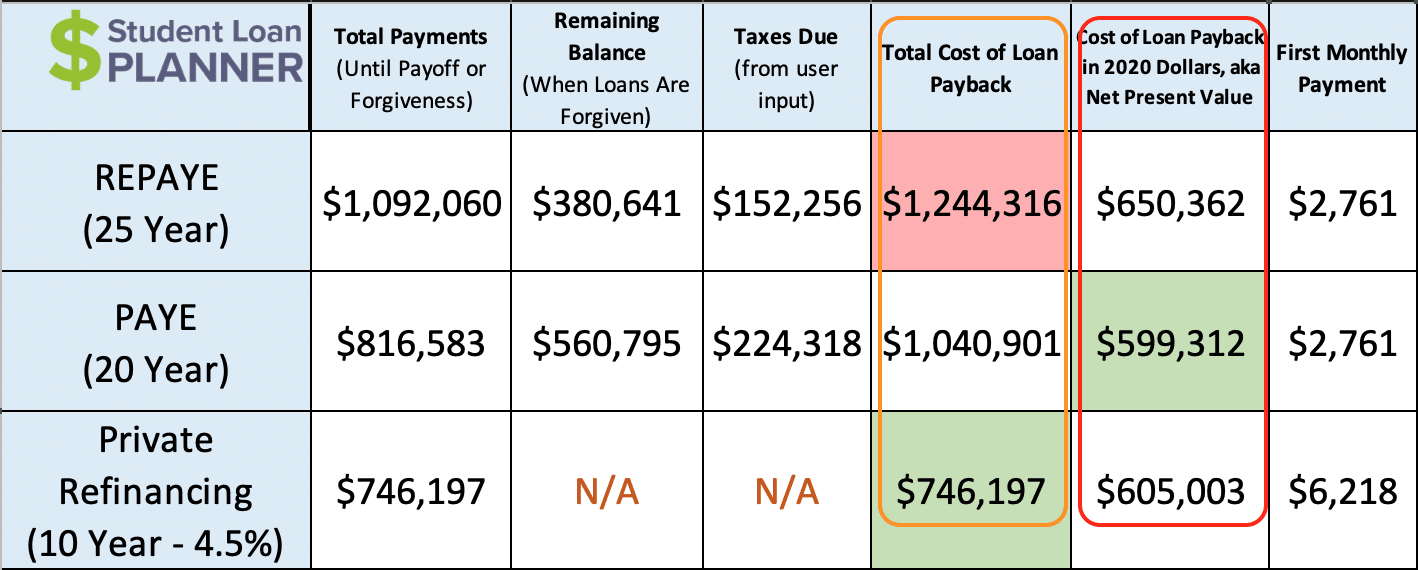
We’ll remove REPAYE from the running. It's the most expensive way to pay back the loans of the three options. This result is mainly because of making income-driven payments for five extra years versus the PAYE plan.
PAYE vs. refinancing in action
PAYE versus refinancing needs more consideration, though, because the numbers are a little confusing.
Refinancing could be appealing. It gets Anthony out of debt in 10 years and costs him the least amount of money ($746,197 in total payments). The downside is that he has to commit to making $6,218 in student loan payments for 10 years. That could get in the way of saving up for an orthodontics practice or other financial goals like buying a house.
PAYE could also be appealing because the lower payments based upon his income make it possible to achieve other financial goals. Payments based upon his $350,000 income are $2,761. This is about $3,500 a month less than refinancing, which is extra cash flow to go toward other goals. On the downside, however, it would take 20 years to be debt free.
The tricky part of the analysis is that even though refinancing costs $300,000 less than PAYE when we look at the out-of-pocket cost, the net present value is pretty much the same.
What does that mean? When we take into account inflation at 3% and a potential 5% investment return on the payment difference, Anthony would end up in pretty much the same spot financially no matter which option he chooses.
With that in mind, I’d lean toward PAYE and save aggressively on the side. The loan strategy is pretty much a wash. But he could get himself in a position to own an orthodontics practice, which would enable him to ramp up his income. Plus, he’d have access to legitimate business deductions and retirement plan contributions from both the employer and employee side. This strategy could reduce his adjusted gross income. In turn, he would lower his payments on PAYE and the overall cost of PAYE compared to the above projection.
We’re just looking at this individual scenario. But any orthodontist’s student loan repayment strategy will vary depending on income, amount of student debt, practice ownership goals, spouse’s income, student debt situation and other factors.
Is the average orthodontist salary worth the student debt?
Deciding whether pursuing a career as an orthodontist is worth the cost is a tough call. So, let’s talk through it.
The amount of student debt needed to become an orthodontist is only part of the picture. What really matters is how much it will cost to pay back the debt and how much extra salary can be earned compared to taking on the debt. Let’s look at a comparison to a general dentist.
The numbers show that a general dentist practice owner makes about $201,000 on average with $388,000 of student debt. An orthodontic practice owner makes about $353,000 and has $597,000 of debt.
The projected cost to pay back student debt for a general dentist is about $622,000 out of pocket using PAYE. The projected cost for an orthodontist is $1,040,000 on PAYE.
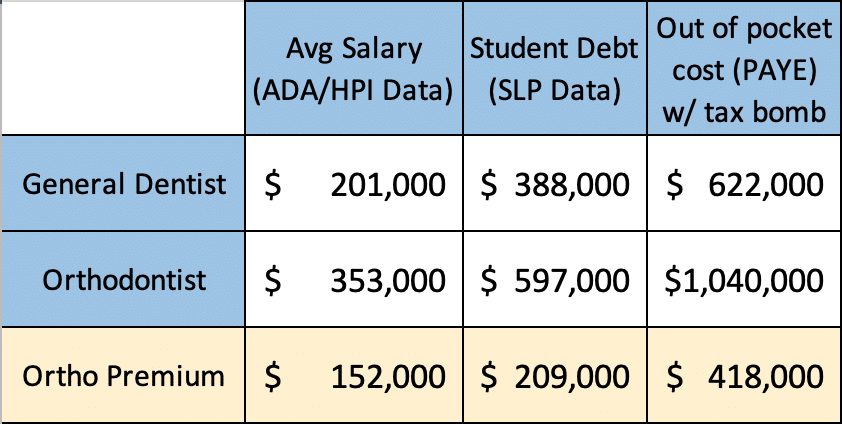
A practice-owning orthodontist can make $152,000 more than a general dentist practice owner. Let’s say that the orthodontist is in a 40% marginal tax bracket (federal and state). So, they take home an extra $91,200 per year. The extra cost of loan repayment is projected to be $418,000.
At that rate, it would take about 4.6 years for an orthodontist to earn enough after-tax money to compensate for the higher debt load. In other words, an orthodontist can recoup the extra cost of orthodontics residency within five years of practicing.
The orthodontist is also missing out on three years of earning $200,000 or more per year to take on the extra certification compared to a dentist, however. It would take 4.5 years after completing the three-year residency to break even with a general dentist.
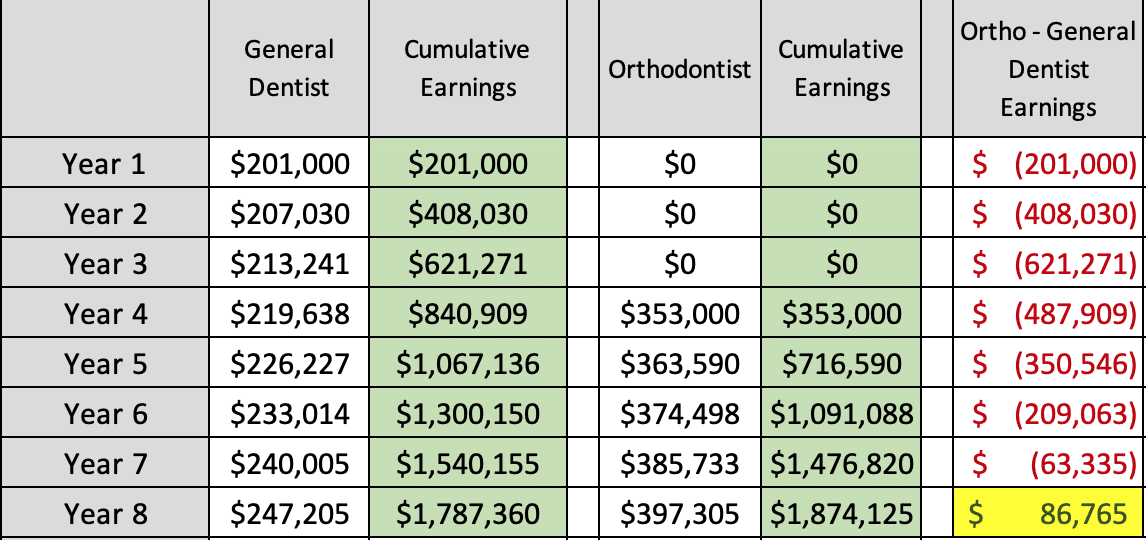
When we look at the fact that it will take 7.5 years to break even with a general dentist's earnings and add the 4.5 years to pay for the extra orthodontist student debt, it would take 12 years for an orthodontist to “catch up” to a general dentist.
Bottom line: Orthodontist student debt is worth it with the right plan
Is the debt worth it to become an orthodontist? The answer is yes from a pure numbers standpoint, but it’s a long and costly road. Orthodontists need to be sure that it’s a path they want to take before committing to school and residency.
I’m not sure it’s worth it if an orthodontist has no plans to open up a practice and lives in a highly populated city on one of the coasts because the earning potential is lower.
That being said, the tables turn to being worth it for a practice-owning orthodontist who plans to live in a place outside of the top 10 most populated areas. They’d also want to avoid private dental school and expensive orthodontics residency programs to keep the relative debt to a minimum, as far as orthodontists go.
Check out our orthodontist student loan guide for more details about how these choices can drastically affect student loan repayment.
Orthodontists can get a solid student loan repayment plan
Orthodontists and other dental professionals can find a clear path to pay back their student loans — one that could not only save them significantly more money but also could give them a step-by-step action plan to get it done. An orthodontist salary can be quite substantial. But part of figuring out whether it’s worth the debt load depends on your loan repayment strategy and your career choices.
Student Loan Planner® has done thousands of student loan consultations for clients totaling over $1.9 billion of student loan debt. Whether you’re a practice owner, striving to be one, or happy to be an employee, we can help you figure out the optimal repayment plan in just one hour. Plus, we include email support after the consultation to continue to answer your questions and help you implement the plan.
Income & Student Debt by Profession
How you compare to other
accountants stats*
| Average student debt | |
| Average income | |
| Average Debt-to-Income Ratio |
Statistics represent the population of Student Loan Planner clients in the respective profession referenced in the chart from 2017-2023. Sample excludes those in school or in training.*
